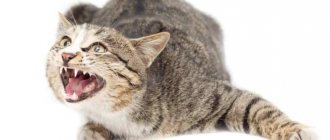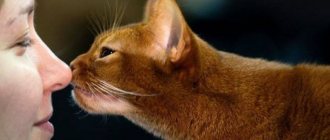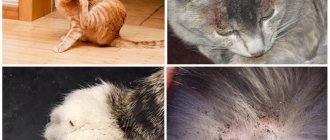Many cats are sociable and active. However, when you suddenly notice that your cat becomes quiet and calm, it could be a sign of sadness.
Many owners fail to recognize the signs of a depressed or sad cat. It is very important for you to know the various causes of sadness in cats and the best ways to make them happy.
Cats are emotional and can become stressed or depressed. The most common signs of an unhappy cat are cowering, hissing, and running away.
But sometimes your cat may not show obvious signs of stress. This is why you, as a pet owner, need to know how cats behave when they are depressed.
- Reasons why your cat is sad
- Losing a loved one
- Trauma, damage
- Disease
- Signs of a Sad Cat Low Energy Levels
- Changes in care
- Pain
- Changes in appetite
- Changing your daily routine
- Aggression
- These include:
- Buy toys for your cat
Signs of a Sad Cat
Your cat may show subtle signs of stress, making it difficult to notice any changes in behavior. To determine if your cat is unwell, check for these possible signs of depression:
Low energy level
Cats usually sleep a lot. A depressed cat will sleep even more. If you notice a sudden change in your cat's sleep pattern, it means she may be unhappy.
Unusually low energy levels are a red flag for an unhappy cat, suggesting mental or physical problems.
Changes in care
Depressed cats usually stop grooming themselves, leaving themselves unkempt.
Pain
Pain is one of the most underdiagnosed conditions in cats, especially in older adults. This is one of the main clinical signs of depression.
Changes in appetite
If your cat changes its usual eating behavior, it could be a sign of depression. Sad cats may lose interest in their regular diet.
Changing your daily routine
A cat that suddenly changes its behavior may be stressed. Have they stopped using the litter box? Do they leave their usual sleeping area? A sad cat may lose interest in the activity that initially made him happy.
Aggression
A sad cat becomes more aggressive. Examples of aggressive behavior in cats include hissing, biting, chasing, and growling. If you notice this behavior, it may be time to visit your veterinarian.
Reasons why a cat is sad
There can be several causes of depression in a cat. Cats can grieve. They bond with human and non-human family members and may grieve when relationship dynamics are lost. Regardless of the reason, be sure to give him extra time and attention until his happiness level improves. If the cause is pain, take your cat to the vet.
Disease
Illnesses may make your cat feel unwell and even in pain. A cat may not be playful if it hurts to move. Your cat may feel nauseous, may not want to eat, may have a hormonal imbalance, or may be losing energy due to illness.
Conditions such as fatty liver disease, FIV, FeLV, upper respiratory disease, diabetes, hypothyroidism, dental disease and others are serious health concerns that can affect your cat's happiness level. If you suspect your cat is depressed due to illness, you should schedule a visit with your veterinarian as soon as possible.
© shutterstock
Trauma, damage
Injuries can limit your cat's ability to do things she used to enjoy. Pain following an injury can also prevent your cat from feeling as happy as usual.
Make sure you follow your veterinarian's recommendations for pain relief, or if you think your cat is in pain, make an appointment to have her checked. Even old surgeries and injuries can cause your cat ongoing pain or discomfort and may require chronic pain management.
Losing a loved one
Losing a family member is always difficult for anyone, and your cat is no exception. When a family member (human or animal) dies or moves away, your cat may grieve and become depressed. This behavior is usually temporary and your cat will return to normal over time.
If your cat is depressed because another cat in the house passed away, she may (or may not) benefit from a new feline friend. Be careful about adding another housemate to the family too early. Time is usually the best remedy for major changes in a family member, but there are also natural remedies, such as pheromones and nutritional supplements, that can help your cat become happier in the meantime.
Article author: Amy Shojai . Amy Shojai has 25 years of experience as a pet expert, media personality, award-winning pet care author, and certified animal behavior consultant.
How to make a cat happy
There are several ways to make your sad cat happy.
These include:
Make time for games. Depressed cats will get rid of their aggression if you play with them.
Pet the cat. Cats love to communicate with their owners (although in the case of cats, you still need to think about who the owners are - cats or people). Your gentle, stroking hand can stabilize an anxious cat without restricting its movement.
Using catnip. Catnip is a plant in the mint family that contains the natural oil nepetalactone, which has unique effects on cats. When cats rub or chew catnip, it produces a mild, natural high that is both safe and temporary, but enjoyable for cats.
Specialist consultations. A certified animal behaviorist may be your best choice to cheer up your pet, as they have the knowledge and experience to treat depressed pets.
When to call the vet. If you notice that your cat is showing signs of chronic depression, stress or illness, you should contact your veterinarian. Your veterinarian may recommend medical intervention or simply change your daily routine.
Signs of a sick cat include:
- Loss of appetite
- Changing your sleep pattern
- Crying or searching
- Need for extra attention
- Overall sad behavior
Experts identify 10 main signs of depression:
- apathy, refusal to eat, even treats and activity;
- increased irritability, desire to hide, to be alone;
- sudden mood changes;
- refusal to care for your fur;
- damage to furniture and other items;
- plaintive, causeless meows;
- refusal to go to the toilet in your litter box;
- attempts to mark territory in sterilized cats;
- change in behavior: an affectionate cat suddenly becomes angry and aggressive.
Often, owners do not notice the first signs of depression in their pet. In addition, disturbances in the psycho-emotional state can be caused by hormonal changes or problems in the functioning of internal organs. Therefore, first you need to contact your veterinarian.
Cat care
Cats are wonderful animals. However, before purchasing one for your pet, you should know what they need and how to make them happy.
Needs of cats. Unlike pets such as a dog, cats do not require much socialization, training, or exercise. They are quite unpretentious.
Cats tend to be more independent and can adapt well if you lead a busy lifestyle. They can also be handy if you live in a small apartment or house.
How to stop your cat from being sad. There are several ways to protect your cat from sadness:
Buy toys for your cat
Toys will keep your cat busy and tired, thereby getting rid of excess energy.
Keep cats in pairs
This will help improve communication and find playmates, reducing or preventing stress.
Let your cat "hunt"
Imitating hunting behavior keeps cats mentally stimulated and active.
Walk the cat
Exercising your cat will help you get rid of excess energy and stress. Contact a professional trainer to teach your cat how to walk on a leash.
How to help get out of depression?
The owner needs to devote more time to the animal and try to distract it by any means. You can force him to hunt and try to encourage him to take action, including play. If the cat does not want to be active, you should not press on it. It is better to treat her with treats, be nearby, stroke her and talk affectionately.
Cats are very fond of elevations and various houses. They can be purchased at a pet store or made yourself. You also need to give your pet more space to run around, for example, chasing a laser pointer. Don’t forget about having a scratching post in the house - scratching surfaces is the norm for these animals, reports the Ivethelp website.
Cats are mysterious animals. Even the owner is not always able to determine what mood his pet is in. Despite this, experts from the British Veterinary Association explained that a cat’s emotions can be determined quite accurately by its tail.
Expanding our horizons
Another way to add variety to your cat's space is to choose toys that stimulate different senses. For example, many cats are of great interest in the olfactory mat, in the secluded corners of which she will look for a treat. Also, various balls or cups, where access to food opens after solving the puzzle, will cheer up a bored cat.
Cats may also enjoy the ball maze and massagers.
It is necessary to remember that a cat is like a small child - it will quickly get tired of the same toy. But this does not mean that you need to constantly buy new ones. It is enough to hide some of the toys from the cat and once every ten days replace those that the pet has already become accustomed to.
How to help your pet
First and foremost, if your pet is showing symptoms of depression, it is important to visit a trusted veterinarian to rule out physiological causes. If your cat is lethargic and sad, this may indicate health problems. Perhaps something hurts her. If everything is fine with the body, then it’s worth thinking about psychological reasons.
- It is recommended to analyze what has changed in the life of your pet in an alarming way recently? Possible causes of stress should be eliminated or reduced;
- It is necessary to establish a clear daily routine and routine actions, rituals so that the cat feels safe and the owner’s routine and behavior are predictable. It's calming;
- It is important to provide the animal with everything necessary for a comfortable life - food, shelter, toys, attention. For example, if the problem is a new pet, then you should pay more attention to both and provide places where you can retire. It is very important to provide every animal with the necessary resources to prevent depression;
- Provide the cat with enough mental stimulation and entertainment - games, a place to watch the street on the windowsill, there are even special films that can be turned on for the animal if the owner leaves the house for a long time;
- In more complex cases, it is worth asking for help from an animal psychologist;
- Veterinarians may also recommend giving your cat antidepressants. This is a common practice to correct behavior and improve the pet's quality of life. This is an extreme measure, since all such pills have side effects, but sometimes it is necessary.
Cats are sad and with their emotions show their owners that they need something. Therefore, it is important to learn how to respond correctly to your pet’s anxiety and sadness. In order to find out how accurately you understand your cat, American scientists have developed a special test. When your pet is sad, you can help your little friend with regular communication. Showing him more attention will often be enough. And if the condition persists, then it is necessary to show your pet to a veterinarian. Love and care will help the animal feel happy again.
Sadness in cats
Cats can experience different emotions as realistically as humans because all mammals have fundamentally similar brain structures. The emotion of sadness in cats is more complex than, for example, the basic emotions of joy or fear. Most often, sad cats have their whiskers down, their ears flattened, their tail curled around their body, and the animal itself presses to the floor, refuses its usual activity, affection, and loses interest in its surroundings, sometimes even showing aggression. A sad cat may cry, meow, and even purr loudly and often to comfort itself.
Is there a sad cat breed? The famous Grumpy cat Tardar immediately comes to mind, who was outbred and looked sad due to a congenital pathology of his muzzle. It's possible that some British Shorthairs may look sadder than others, but this is very subjective.











